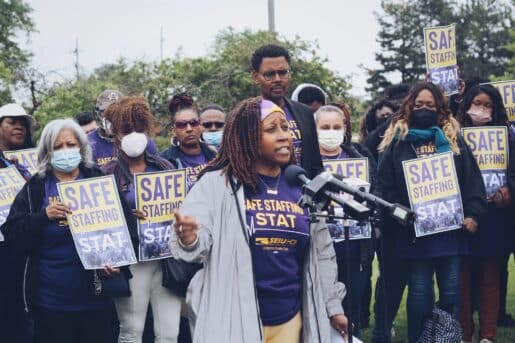Concerned healthcare workers in Illinois and Indiana are calling on The Joint Commission to add a safe staffing standard to its accreditation process.
Yolanda Stewart, a patient care technician at Northwestern Memorial Hospital, once injured her back so badly on the job that she couldn’t work for six months. But when she talks about that time, she doesn’t mention her own pain. Instead, she talks about the patient she’d been trying to help, recalling his extreme discomfort.
Because the unit was short-staffed, Stewart lifted and turned the patient on her own. The move helped the patient but cost Stewart. Many healthcare workers have similar stories, she says, adding, “Working short-staffed is a safety issue for workers and patients.”
In fact, reports show that lack of staff in hospitals leads to higher patient infection and death rates. Meanwhile, a 2018 study in the European Journal of Cardiovascular Nursing associated higher staffing levels with lower death rates, fewer medication errors, and fewer infections.
Hospitals pay close attention to those rates because they care about patient outcomes, and because those outcomes impact their accreditation status and third-party reporting to the community.
Yet, Covid-19 has greatly worsened the healthcare staffing shortage, with 1 in 5 hospital employees — from environmental services workers to nurses — leaving the field. Hospitals have grappled with staffing issues since before the pandemic, but Covid-19 highlighted the challenges — and exacerbated them.
Safe staffing standards
Now, concerned healthcare workers throughout Illinois and Indiana are sounding the alarm. They’re calling on The Joint Commission — the third-party agency that accredits 22,000 healthcare organizations nationwide — to add a safe staffing standard to its accreditation process, similar to student-to-teacher ratio requirements that many states have. In early June, about 75 healthcare workers rallied outside The Joint Commission’s headquarters in Oakbrook Terrace. They then taped to the agency’s front doors an 18-foot long petition calling for safe staffing standards that thousands of healthcare workers had signed.

“We have all kinds of rules to make sure that hospitals are safe: We make sure that healthcare workers wash their hands before procedures, that they wear gloves and protective equipment, that bed sheets are changed between patients. Yet there are no statewide regulations about hospital staffing levels,” said Service Employees International Union (SEIU) Healthcare Illinois President Greg Kelley at a demonstration in early June. SEIU represents nearly 2 million workers in the U.S. and Canada.
Cook County Commissioner Brandon Johnson, who represents Chicago’s West Side and the west suburbs in the 1st district, says the matter comes down to public safety. “This is a matter of whether someone lives or dies. It’s not unreasonable to expect and require that The Joint Commission do what’s right for the patients and do what’s right for those who serve the patients.”
A critical and complex issue
Jackie Craig has served patients at Loretto Hospital for five years, working in environmental services. “Patients [in the ER] are always waiting for rooms when I show up each and every day. That’s an awful feeling knowing that the person is sick and possibly in pain and needs a room, but is waiting on me to do my job,” Craig says. “I only can do so much as one person, not the job of two, three, or four people at one time. I live in the community with the people I see each and every day, and I do my best to make sure they’re comfortable.”
Joint Commission President and CEO Jonathan B. Perlin, MD, PhD, responded via a written statement, saying that Covid-19 has amplified the stress and exhaustion many healthcare workers feel. “The events of the past two years have brought critical attention to the need for more trained healthcare workers to meet patient demand and to reduce turnover. We appreciate that without a healthy and safe workforce, we cannot have the safest and most compassionate care.”
Perlin calls staffing “a critical and complex issue” that The Joint Commission takes seriously, but says the workforce shortage adds to the challenge. “There is not a one-size-fits-all or immediate solution, especially in the context of ensuring access to patients in need with an ongoing workforce shortage. We look forward to working with other organizations and authorities on this challenging issue to create sustainable improvements for both healthcare workers and the patients we serve,” he writes.
Workers with decades of experience in healthcare hope those improvements happen, as their chants and purple signs declared, “Stat.”












